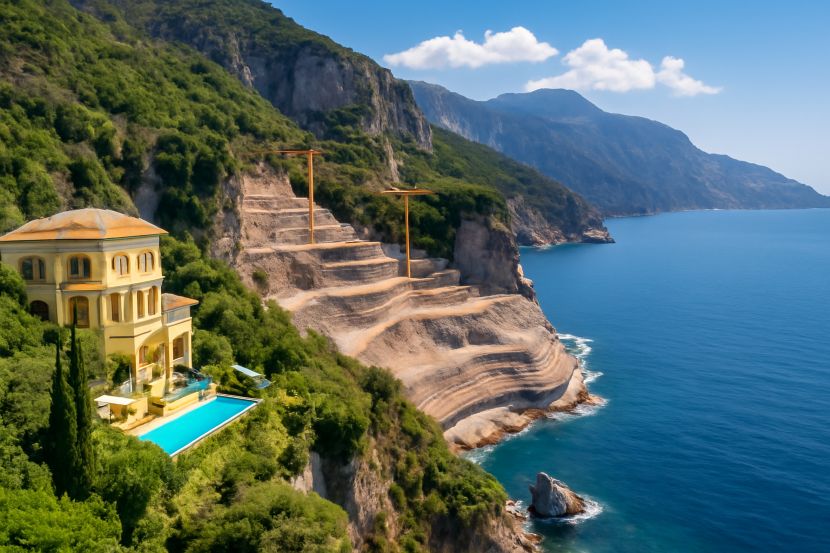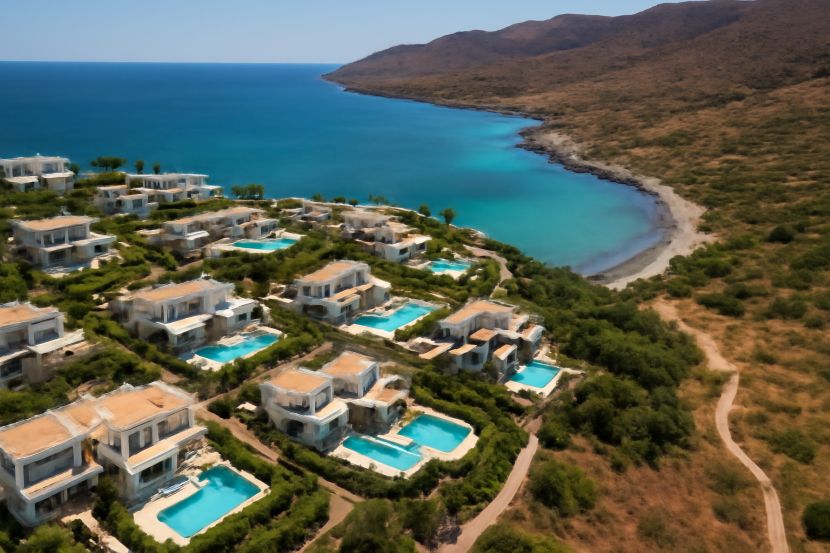Published on
November 16, 2025

Luxury tourism is a booming industry, attracting affluent travellers who are eager to experience the finest accommodations, exclusive resorts, and opulent villas in some of the world’s most beautiful destinations. However, as the demand for luxury travel continues to grow, the impact on the environment is becoming increasingly evident. From the pristine coastlines of Greece and Spain to the cultural heritage sites of Italy and Croatia, luxury tourism is putting immense pressure on natural resources, fragile ecosystems, and local communities. This article explores how luxury tourism is contributing to environmental degradation in several countries, highlighting the urgent need for sustainable solutions to preserve these precious destinations for future generations.
Greece: Water-Stressed Islands and Fragile Ecosystems at Risk
Greece’s islands have long been known for their stunning beauty, clear blue waters, and idyllic landscapes. However, as luxury tourism continues to flourish, these islands are facing serious environmental challenges. The demand for high-end villas, private pools, and lavish resorts has led to an unsustainable use of freshwater resources. Water, which is already in short supply on many Greek islands, is being consumed at alarming rates to meet the needs of tourists staying in luxury properties.
In addition to the strain on water resources, the rapid construction of luxury tourism infrastructure is taking a toll on Greece’s fragile ecosystems. Coastal areas, once pristine and untouched, are being developed to accommodate wealthy visitors, threatening local wildlife habitats and contributing to the loss of biodiversity. The country’s natural beauty, which attracts millions of tourists every year, is at risk of being permanently damaged by the unchecked growth of luxury tourism.
Spain: Straining Resources and Altering the Landscape
Spain is another country where luxury tourism is having a profound impact on the environment. Coastal areas and islands, which have traditionally attracted high-end tourists, are now facing significant challenges as the demand for luxury accommodations and experiences grows. The need for water, energy, and other resources to sustain luxury resorts and private villas is putting an enormous strain on local infrastructure and the environment.
Luxury tourism in Spain is also contributing to the alteration of the landscape. Coastal zones, once home to rich ecosystems, are being transformed into sprawling resorts and luxury properties. These developments not only disrupt local wildlife but also change the natural character of Spain’s coastline, potentially causing irreversible damage to its marine and terrestrial ecosystems. The pressure on Spain’s natural resources and landscapes is a clear indication that the current model of luxury tourism cannot continue unchecked.
Italy: A Growing Threat to Natural Zones and Cultural Heritage
Italy, renowned for its rich history, art, and natural beauty, is another destination feeling the strain of luxury tourism. The country’s famous coastal regions, such as the Amalfi Coast, and historic cities like Venice and Florence are experiencing a surge in luxury travel. While this has boosted Italy’s economy, the environmental cost is becoming increasingly apparent.
The growth of luxury tourism is leading to significant land-use changes, as luxury resorts, villas, and private amenities are being built in areas that were once protected for their natural beauty. This construction boom is placing increasing pressure on Italy’s fragile ecosystems, including coastal and mountainous regions. As these developments continue, the risk of habitat loss, pollution, and the degradation of Italy’s natural heritage grows. The challenge facing Italy is how to maintain its cultural and environmental integrity while accommodating the demands of the luxury tourism sector.

Croatia: The Cost of Luxury Travel on Heritage and Nature
Croatia has become an increasingly popular destination for luxury tourists, with its crystal-clear waters, medieval cities, and stunning Adriatic coastline. However, the influx of high-end tourists is taking a significant toll on the country’s environment and heritage. Cities like Dubrovnik, once quiet gems, are now being overrun by the demand for luxury accommodations and exclusive experiences.
The pressure from luxury tourism is leading to overdevelopment in certain areas, particularly along the coastline. New luxury resorts, private villas, and exclusive tourist attractions are being built at the expense of Croatia’s natural spaces. This development is not only harming the environment but also putting Croatia’s rich cultural heritage at risk. The sheer volume of luxury tourists visiting the country is straining local resources and threatening the very elements that made Croatia a desirable destination in the first place.
Portugal: Coastal Development Threatening Natural Resources
Portugal, with its breathtaking coastline and historic charm, has seen a rise in luxury tourism, particularly in its coastal regions. While the country continues to attract high-end travellers, the environmental impacts are becoming more pronounced. The construction of luxury resorts and private villas along Portugal’s coastline is leading to land-use changes that threaten local ecosystems.
The demand for luxury tourism is also putting a strain on Portugal’s water and energy resources. Resorts and private properties require substantial amounts of water, much of which is sourced from the country’s already limited supply. As these developments continue to expand, Portugal’s natural resources are being pushed to their limits. The growing environmental pressures caused by luxury tourism highlight the need for more sustainable practices to protect the country’s stunning coastal and marine zones.
France: Habitat Damage from Increased Tourism Pressure
France is home to some of the world’s most iconic natural sites, including the French Riviera, the Alps, and the Loire Valley. These areas are renowned for their beauty and have long been favoured by luxury tourists seeking an exclusive escape. However, the growing number of high-end tourists is beginning to take its toll on France’s natural landscapes.
Luxury tourism in France is contributing to habitat damage, particularly in areas that were once protected for their environmental significance. Popular destinations like the French Riviera are experiencing increased footfall, leading to habitat degradation and pollution. The country’s natural beauty, which has attracted visitors for centuries, is under threat from the pressure of luxury tourism. As more resorts and high-end properties are developed, France must address the environmental cost of its tourism industry.
Germany: Nature Destinations Under Strain from Luxury Tourism
Germany, known for its vast forests, mountains, and nature reserves, is also facing the impact of luxury tourism. High-end tourists are flocking to the country’s scenic regions, such as the Bavarian Alps and the Black Forest, seeking an exclusive experience. While these areas offer breathtaking natural beauty, they are struggling to cope with the demands of luxury tourism.
The construction of luxury resorts and private villas in these sensitive regions is putting immense pressure on Germany’s fragile ecosystems. These developments are disrupting local wildlife, contributing to pollution, and causing irreversible changes to the landscape. As Germany continues to attract luxury tourists, the country must find a way to balance the economic benefits of tourism with the need to protect its natural environments.
Cyprus: Infrastructure Pressure and Environmental Degradation
Cyprus, a popular destination for luxury tourists, is facing its own set of challenges as the demand for exclusive experiences grows. The construction of luxury resorts and private villas is leading to significant infrastructure pressures, particularly in natural areas that were once protected.
The expansion of tourism in Cyprus is causing fragmentation of natural habitats, threatening local wildlife and disrupting ecosystems. The rapid development of luxury properties is taking a toll on the island’s biodiversity, as more land is cleared for resorts and infrastructure. Cyprus’s environment is under threat from the increasing demands of luxury tourism, and the country must take steps to ensure that its natural beauty is preserved for future generations.

Belgium and Poland: Luxury Tourism Putting Pressure on Resources
While Belgium and Poland are not as heavily impacted by luxury tourism as some other European countries, they are still feeling the effects of tourism-related pressures. In Belgium, the tourism-environment assessment highlights the growing concerns about the impact of luxury travel on water and land resources. Similarly, Poland is facing challenges in balancing the growth of its luxury tourism sector with the need for environmental sustainability.
Both countries are at a crossroads, as they navigate the delicate balance between economic growth and environmental preservation. The growing demand for luxury tourism in these nations is putting pressure on their natural resources, and the need for sustainable practices is becoming increasingly urgent.
The Urgent Need for Sustainable Luxury Tourism
The environmental impact of luxury tourism is undeniable. As countries across Europe face growing pressures from the development of high-end resorts, villas, and infrastructure, the need for sustainable solutions has never been more urgent. Governments, tourism industries, and travellers must work together to create a model of luxury tourism that respects the environment and preserves the natural beauty that attracts visitors in the first place.
By adopting sustainable practices, supporting local communities, and prioritising environmental conservation, luxury tourism can be reimagined as a force for good. If countries like Greece, Spain, Italy, and others continue down the current path, they risk losing the very landscapes and ecosystems that make them so special. The future of luxury tourism depends on our ability to protect these destinations for generations to come.

